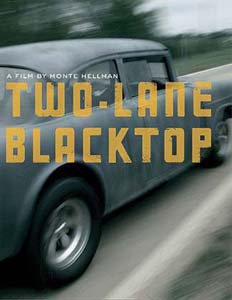 A tuned, grey-primered ‘55 Chevy, stripped of all unnecessary clutter & built to race. Two guys, living in the car & cheap motels, travelling the mid-western States, earning money for petrol, parts & food by hustling the locals at small town drag races; challenging a GTO driver to a race across the country, the ownership papers of their cars as the prize.
A tuned, grey-primered ‘55 Chevy, stripped of all unnecessary clutter & built to race. Two guys, living in the car & cheap motels, travelling the mid-western States, earning money for petrol, parts & food by hustling the locals at small town drag races; challenging a GTO driver to a race across the country, the ownership papers of their cars as the prize.
Sounds like the perfect premise for a true petrol head’s film -& to many fans it is. This is one of those films that attained cult status almost the day it was released. Personally though, I found it kinda disappointing. It could’ve been a high octane, action packed, tyre squealing, foot to the floor celebration of life on the road & living for the thrill of speed & an open highway. In other hands I’m sure it would’ve been, but director Monte Hellman, known for his intense, soul searching art films, had other ideas. Although shot in 1971, he described Two-Lane as “The last film of the 60s” referring to that decade’s hippyish search for self enlightenment, direction & purpose to life. Among his previous films were a pair of Westerns, "Ride in the whirlwind” & “The shooting”, both starring Jack Nicholson & equally, darkly introspective. 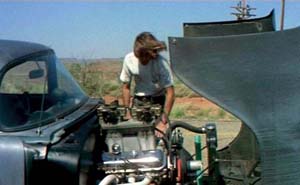
This film’s minimal to say the least. The four main characters don’t even have names; they’re referred to simply as The Driver, The Mechanic, The Girl & GTO, though only in print -in the film they’re never named at all. The script consists of barely a dozen lines for each actor, with the notable exception of GTO played by Warren Oates, who’d co-starred in the earlier “Shooting” Western. There’s no soundtrack music, just the occasional disinterested utterance from the players & the sound of that gorgeous 454 cube Chevy. An air of improvisation surrounds the whole production. Hellman took his film crew on a real road trip, filming the whole story in chronological order as they moved East from LA towards Washington DC & only giving the cast their lines the night before each scene was due to be shot.
 The story, such as it is, concerns the Driver & the Mechanic, working their way from one small town illegal road race to the next, earning a few dollars in prize money & moving on. At a truck-stop the Girl stows away aboard the Chevy. Far from causing uproar, it’s simply accepted with a shrug & the trio travel on. The one break from this monotonous, monosyllabic, monochrome world comes in the form of Oates’ character. He drives a bright yellow Plymouth GTO & attempts to impress a succession of hitch
The story, such as it is, concerns the Driver & the Mechanic, working their way from one small town illegal road race to the next, earning a few dollars in prize money & moving on. At a truck-stop the Girl stows away aboard the Chevy. Far from causing uproar, it’s simply accepted with a shrug & the trio travel on. The one break from this monotonous, monosyllabic, monochrome world comes in the form of Oates’ character. He drives a bright yellow Plymouth GTO & attempts to impress a succession of hitch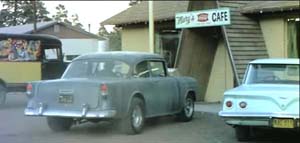 hikers with imaginary life stories, never revealing which may be the true one or the purpose of his endless journey. The Chevy crew goad him into a road race, the first to reach Washington winning the other’s car. The wager’s simply an excuse to keep travelling though & is gradually abandoned with the occupants helping each other & even swapping cars several times along the way. Eventually the Girl tires of the 3 guys, silently walking out of yet another truck-stop & climbing aboard a passing Harley to ride off in another direction. GTO is left to regale the diners with his make-believe exploits & the Driver & his companion move on. The film ends
hikers with imaginary life stories, never revealing which may be the true one or the purpose of his endless journey. The Chevy crew goad him into a road race, the first to reach Washington winning the other’s car. The wager’s simply an excuse to keep travelling though & is gradually abandoned with the occupants helping each other & even swapping cars several times along the way. Eventually the Girl tires of the 3 guys, silently walking out of yet another truck-stop & climbing aboard a passing Harley to ride off in another direction. GTO is left to regale the diners with his make-believe exploits & the Driver & his companion move on. The film ends 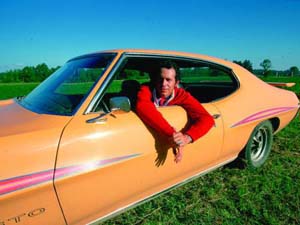 suddenly & inconclusively as they prepare for yet another race.
suddenly & inconclusively as they prepare for yet another race.
This is basically a 4 wheeled version of EasyRider, filmed at around the same time & produced by the same studio, drawing the same metaphors between the road trip & the journey through life, searching for freedom & fulfilment. It’s not so much a car film as an existential exploration that happens to feature great cars!
So what is there to interest the shallower viewer?
Monte Hellman cast 3 complete novices as his Chevy occupants. 17 year old waif-like Laurie Bird was straight out of High school & had never acted before. She only worked on 2 more films before committing suicide at the tender age of 26 while living with Art Garfunkel.
The film was given credibility with the newly discovered youth market by casting rock star James Taylor as the Driver. His partner Joni Mitchell, most famous for her composition Big Yellow Taxi, joined him on location for much of the trip.
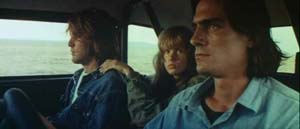 The part of the Mechanic proved hardest to fill, with Hellman resorting to approaching car enthusiasts in filling stations before deciding on Dennis Wilson, drummer with the Beach Boys, just 4 days before filming began. This was his only foray into acting.
The part of the Mechanic proved hardest to fill, with Hellman resorting to approaching car enthusiasts in filling stations before deciding on Dennis Wilson, drummer with the Beach Boys, just 4 days before filming began. This was his only foray into acting.
The real star of the movie has to be the car though.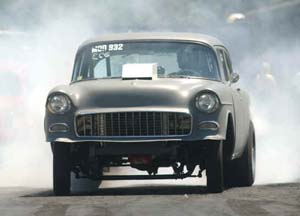
3 identical ’55 Chevy 150 sedans were commissioned from Richard Ruth of Competition Engineering in Sunland, California. General Motors supplied 2 454ci Chevy big block engines, which were used in the cars used for exterior & interior shots, & a 2 year old L-88 427 motor for the stunt car. The 2 main vehicles were fitted with fibreglass flip fronts, boot lids & doors, with sliding plexi-glass windows, while the stunt car was all steel & had a full roll cage & a special dual braking system, allowing either the left or right wheels to be locked for intentional skids. This set-up was never used in the film though. The storyline called for the stunt car to be rolled while avoiding a road accident but in the end it was simply driven off the road into a field. All the Chevys featured distinctive large radiused rear wheel arches to 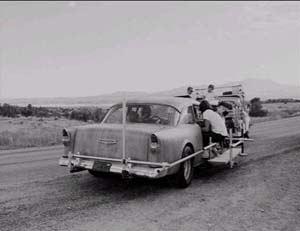 allow fitment of the racing slicks carried in the boot & tunnel rams over the dual Holley carbs poking up through the bonnet. The interiors were stripped with the rear seats removed & two bucket seats up front. Richard Ruth supplied the cars in baby blue paintwork but this was replaced with simple grey primer to fit the no-nonsense racing image. Incidentally, Ruth had a walk-on part in the film, appearing as a garage mechanic, strolling out to admire the car as Taylor & Wilson stop for petrol.
allow fitment of the racing slicks carried in the boot & tunnel rams over the dual Holley carbs poking up through the bonnet. The interiors were stripped with the rear seats removed & two bucket seats up front. Richard Ruth supplied the cars in baby blue paintwork but this was replaced with simple grey primer to fit the no-nonsense racing image. Incidentally, Ruth had a walk-on part in the film, appearing as a garage mechanic, strolling out to admire the car as Taylor & Wilson stop for petrol.
If this machine looks familiar it’s because it had a second starring role. Once filming on Two Lane finished the 3 Chevys were left in the Universal Studios parking lot. One was sold privately, ending up white with a red stripe as a daily driver for a young college student. This car was later used to dub the engine noises for Burt Reynolds’ Smokey & the Bandit Trans Am.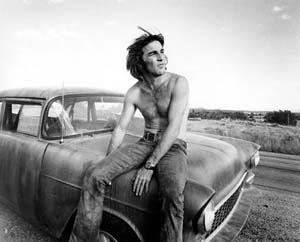
The remaining 2 cars found fame again as the mean, glossy black, street racer piloted by an, as yet, unknown stetson wearing Harrison Ford in “American Graffiti”. The stunt car’s roll cage & Corvico 3 spoke steering wheel can be clearly seen in the Graffiti shots, but the bucket seats were replaced with a standard bench seat & a tonneau cover stretched across from the back of the seat to the rear parcel shelf. The steel stunt car was rolled during the drag race scene with Milner’s yellow ’32 coupe, but a 3rd ’55 was brought in from a local scrap yard for the shots of it burning.
So my verdict? Personally I think Two-Lane BlackTop had the potential to be a great film; all the ingredients were right, but it was ruined by the wrong director. It would’ve been so much more watchable as a straight car film, rather than Hellman’s self indulgent search for freedom. The driving shots, including some interesting period racing footage, are wonderful. The big, rumbling Chevy looks & sounds beautiful, the scenery’s good -but the bits in between are slow & tedious. The script’s non-existent & the main characters don’t engage your interest at all.
It’s a drag racing film that drags.
I’d recommend watching this with the sound turned down during the slow bits & replaced with your own selection of rock music & turned back up for the driving scenes.
-Manky


